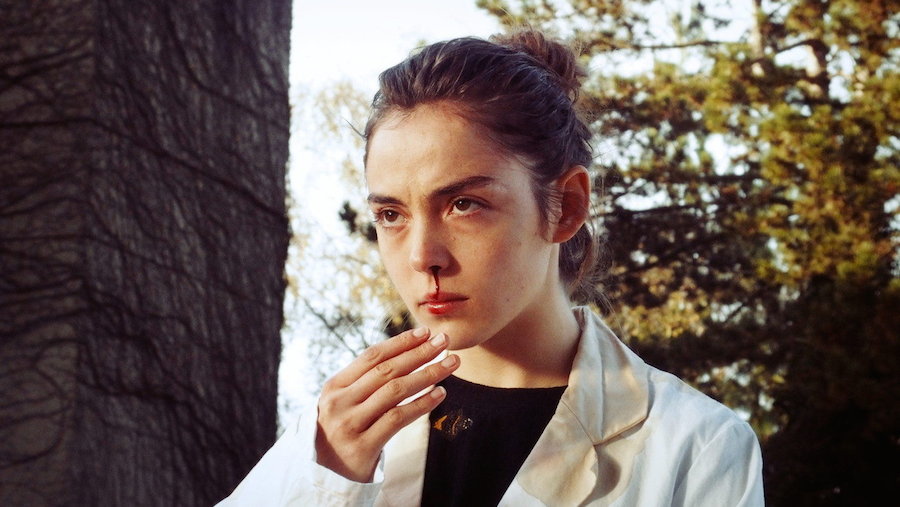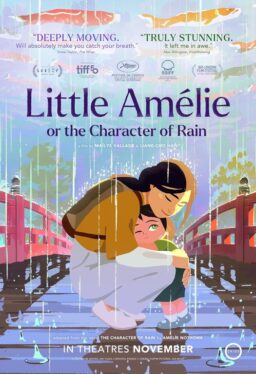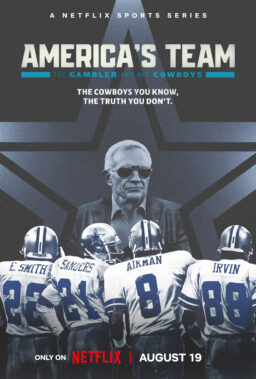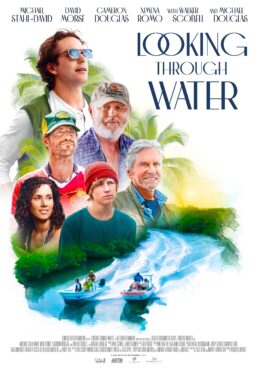“Raw” is an astonishing debut feature for both its writer/director, Julia Ducournau, and its leading lady, Garance Marillier. It won the FIPRESCI Prize at Cannes, reportedly caused audience members to pass out during its screening in Toronto, and earned enthusiastic applause at the Chicago International Film Festival last October. As a tale of cannibalism, it is entrancingly eerie and surprisingly palatable. As a portrait of sexual awakening and self-discovery, it is flat-out brilliant. Marillier plays Justine, a veterinarian student who endures a hazing ritual where she is forced to go against her preferred diet—that is, one devoid of meat. Once she has her first bite of flesh, Justine’s chin gradually lowers as her eyes grow into Kubrickian saucers. Suddenly, she starts looking at her roommate Adrien (Rabah Nait Oufella) with fresh pangs of hunger, while her tight-knit bond with her older sister, Alexia (Ella Rumpf), grows more volatile.
Ducournau spoke with RogerEbert.com about her collaboration with Marillier, the complexity of her visual approach and the provocative use of the film’s memorable score.
How did you and Garance first come together to make the 2011 short film, “Junior”?
I met Garance during the casting of “Junior.” She hadn’t acted before, and was actually training to be a musician at school. I was looking for a tomboy, and because I was only seeing obedient little girls at the auditions, generally speaking, I decided to do another casting call that was much spicier. I wanted to find a 12 or 13-year-old girl who could be super-loud, masculine and not give a f—k. Garance’s mom called us and said, “Listen, my daughter hasn’t done anything close to acting in her whole life, but this character is very much like her, so would you like to see her?” [Laughs] When she came in, she looked like a vulnerable shrimp, and was really cute with her baby face. But the moment she started improvising with me, she got up and she let it go in a way that was so powerful and so disturbingly androgynous that I went, “Woah, what the hell is this hurricane?” She was amazing at the audition and in the short as well, and afterwards, she was in my TV feature, “Mange.” “Raw” is the third collaboration that we’ve had, and in the meantime, we’ve become very close in real life. She’s like my little sister in a lot of ways. It was difficult though because I don’t like to write for actors. I am afraid that it’s going to take me another route, and I don’t want to be too influenced by it. The script should come first. For three years, I tried to forget about Garance, even though we were having lunch together all the time. I told her, “No, no, I’m not thinking about you,” but once I wrote the script, of course I gave it to her.

Both “Junior” and “Raw” display your gift for portraying how young people actually talk to each other, either in a junior high cafeteria or in a college dorm room.
Oh wow, thank you for that! I actually speak with a lot of slang. When I was younger, I spoke that way because I wasn’t making an effort. Now that I know that I can talk normally, I really like slang because of its poetry. It’s a super-visual language, and I think it’s cinematic because it conveys imagery immediately. If you say “motherf—ker,” you can see the image right away. That’s why I use slang quite a lot in my scripts. As for how I’m able to portray young people, I think I’m very much in touch with how I was when I was a teenager. I find teenagers super-endearing. The awkwardness that they exude is frowned upon when it is seen in an adult, but it is actually something that we keep our whole life. We just try to hide it, but teenagers don’t hide it at all. They’re just awkward. They don’t know what to do with their bodies, they don’t know what to say, and they’re a bit all over the place. Either they’re too loud or too quiet and there’s nothing in between. I really like these kind of extremes because they are relatable for everyone. We repress this part of ourselves but it’s still in us.
In fact, Justine’s character was the hardest for me to write, and by write, I mean it was the hardest to have a grasp on. Adrien never changed after the first draft, but it took three or four drafts to get a handle on Justine. The moment it all clicked and I began to understand her is when I started seeing her flaws—not only the flaws in her character but the flaws in her body. She’s not just a nice person after all. She thinks she’s perfect and a genius and she makes the teacher feel bad about her bad grades. She’s so self-centered when Adrien is so nice to her. Once I started seeing her flaws, I started taking her seriously as a character with a possible evolution. I do believe that is the best way to start. You can’t start with someone who is perfect, you have to start with someone who is flawed. Otherwise you have no evolution. I also think flaws are beautiful, in a way. We can relate to them because we all have them.
Justine wants to be a veterinarian in part because of the self-awareness she believes animals possess. After certain primal instincts are awakened in her, Justine experiences her own self-awareness, epitomized by the scene where she kisses her reflection in a mirror.
Yeah, definitely, she’s aware of her power. That’s the moment where she starts being empowered by her needs and desires, and she finally accepts them. That’s why I allowed the full song to play over the scene, and I didn’t cut it. We needed to linger on this moment because it’s when Justine becomes conscious of her body for the first time. “Raw” is often described as a film about people who devour each other, and in the case of this scene, Justine is eating up her own reflection. That’s why the camera is placed behind the mirror and we see her eating the screen as if she’s going to eat the audience as well. She wants to get more and more strength, so she looks in the mirror and consumes herself. You can make a comparison between this scene and the earlier one where she is puking herself up by coughing up her own hair. The mirror scene can be considered a step forward in terms of Justine’s expectations about herself and the empowerment that goes with it. She’s not at the level of self-loathing that she was before.
How did you go about developing the relationship between the sisters? It has such a tender intimacy, which is unforgettably observed in their pissing contest.
What is so great about sisterhood or brotherhood is that when you have a sibling that is the same sex as you are, your body in front of the other person is not shameful. It’s more like you are one body rather than two bodies. There is some kind of fusion. If you want to change your clothes, you don’t mind that the other person sees your boobs or your ass or whatever. I really like that, and I think it’s also a way for the siblings to eat each other up. When they bite each other’s arms, it’s not far from that idea of, “Your body is my body.” It’s a bit sadistic if you think about it. When I was directing Ella at the very beginning, I told her, “Garance’s body is your body. You don’t ask permission to touch her, grab her, push her or move her. You treat her body as if it belongs to you.” That was really important to me because it shows how people devour each other in their relationships. I draw a parallel between the eating of their arms and the scene you mentioned when they are peeing together.
When developing their relationship, I kept thinking of a cell from the body that was dividing. It was undergoing mitosis. Once these cells are divided, there is something that has been torn, and there is pain felt on both sides. Part of the pain is derived from the fact that these two cells resulting from mitosis look like they are the same, but they are actually very different because they are no longer one cell. They are the same but they are the opposite at the same time. That’s what is happening in my movie. These sisters were one cell and they were divided. There is pain in the acceptance of this separation, but the separation has to happen because otherwise Justine’s character would’ve never been able to live by herself and build up her own personality and her own moral canvas.

This theme is reflected by Ruben Impens’ cinematography, particularly when the sisters’ faces overlap in a pane of glass.
You are absolutely right. Ruben and I talked a lot about this idea of the cell being divided. What’s interesting about the overlapping of the faces is in how it creates a third face. Something else has been produced from this separation, which shows that it was not for nothing. The image of their two faces overlapping may look monstrous and somewhat freakish, but at the same time, it’s very positive. This third person is the new skin that Justine now has that frees her to be herself.
I loved the music that you and composer Jim Williams chose to accompany Justine’s first taste of human flesh.
Up to that moment, Justine’s theme is performed with an acoustic guitar. Sometimes it’s used comedically, such as when she has the high heels and finds she can’t walk in them. But once she tastes that flesh, the acoustic guitar becomes an electric guitar. It’s way darker and more punk in a way. Suddenly, her destiny has fallen on her shoulders, and she realizes that she cannot escape it. I really wanted to convey a sense of fatality, and that is how Jim came up with the idea to use the organ. It is a brilliant choice because the organ is the instrument of church that illuminates not only sin but the genealogy of sin. It gives the scene a gothic vibe that I was really aiming for from the beginning, since this is kind of a gothic tale. What I found to be a genius decision on Jim’s part was when he took that same theme and placed it later in the film, during the soccer game. This time, the theme is performed with a harpsichord. It’s so smart because the harpsichord is also a baroque instrument but it is deprived of any religious feeling. The harpsichord is completely pagan, it is Mozart. To take the same theme that had conveyed how Justine was crushed by fatality and destiny, and to transform it into a pagan expression of her empowerment and acceptance of her needs and desires, demonstrates just how deeply Jim was in touch with the character.












